|
Synonyms:
Etymology:
'Periophthalmus' is a compound name from the Greek 'peri' (around), and 'ophthalmôn' (eye), which refers to the wide visual field of these species
the species was named after Toru Takita, a Japanese ecologist who intensively worked on mudskippers (Jaafar & Larson, 2008)
|
Maximum recorded length:
8.0 cm SL (Allen et al., 2002)
Live colouration
(Larson & Takita, 2004; Jaafar & Larson, 2008; Polgar et al., 2010; Takita et al., 2011; pers. obs.: Australia NT):
background colour light brown to grey on dorsum and sides, mottled by whitish irregular blotches on flanks; ventrally whitish, with short whitish vertical stripes visible on lower side of body in some specimens; head
ventrally white, with blackish branchiostegal membranes; blackish irregular blotches on the lower portion of cheeks and opercula; diagnostic dark orange to reddish spots on cheeks and opercula, less numerous on flanks; 5-8 very irregular dorsal dark saddle-like bars are usually visible; D1 with a dark grey to dark red background, distally blackened, and with a very narrow transparent margin; spines unpigmented. D2 with a pale background, two diagnostic parallel black medial stripes, and irregular brownish blotches on the proximal portion of the interradial membrane; caudal fin dusky with few scattered darker spots on medial rays, and ventral rays with an orange tint in some specimens; anal fin orange with a paler margin; pectoral fins dusky; pelvic fins almost unpigmented, both dorsally and ventrally
Colouration on preservation
(Larson & Takita, 2004; Jaafar & Larson, 2008; pers. obs.: Australia NT):
ground colour dorsally and laterally greyish to light brown; ventrally whitish, with short whitish stripes on the lower portion of body visible in some specimens; dark irregular blotches and speckles scattered on head and flanks; dark and irregular dorsal banded pattern frequently visible; few silvery white spots on head sides and flanks. D1 background grey
to blackish, distally darker, with a narrow pale margin and unpigmented spines;
D2 with unpigmented background, two diagnostic black medial stripes, and a series of irregular blotches on the proximal interradial membrane; caudal fin dusky with few scattered darker spots on medial rays; pectoral fins dusky; anal and pelvic
fins whitish
Diagnosis (Larson & Takita, 2004; Jaafar & Larson, 2008):
D1 VII-XI; total D2 elements 12-13; total anal fin elements 11-13; segmented rays of the caudal fin: 16-18; predorsal scale count 22-31; pelvic fins fused for half up to 3/4 of their length, with posterior tips rounded, and a well developed pelvic frenum; D1 margin rounded; dorsal fins not connected by membrane; D2 with two parallel black stripes and unpigmented background; no elongated spines. When alive, dark red spots on head and flanks: in preservative they become silvery whte.
Diet:
carnivorous, opportunistic, apparently only gape-limited (insects, crustaceans, nematodes, gastropods, etc.; adults are mainly crab-eaters (Milward, 1974).
|
|
Ecological notes (Polgar et al., 2010; Takita et al., 2011; pers. obs.: Australia NT):
present on
mudflats, typically in front of the pneumatophore zones of pioneer mangrove forests; or along creek depositional banks with absent or open vegetation coverage, at a distance of less than 2 m from the water's edge during low tide (tide pools, creeks); usually found at a few meters from the vegetation, (Polgar et al., 2010). It digs burrows with the typical periophthalmine "Y shape", whose openings are often concealed in cracks and fenditures in the mud (pers. obs.; Milward, 1974)
left: small creek crossing a stand of Sonneratia and Rhizophora spp.; P. novaeguineaensis was here present on the exposed mudbanks (Doctor's Gully, Darwin, Australia NT)
right: mudflat in front of a dense pneumatophore zone of Sonneratia alba; here this species was found just in front of the pneumatohores (Sisikura I., Fly River delta, Papua New Guinea, WP)
(Photos: A. Sacchetti, 2007, with permission)
|
|
|
|
Remarks:
this species was re-diagnosed by Larson & Takita
(2004) as P. novaeguineaensis Eggert, 1935.
These authors also found two other species in the lots identified as P. novaeguineaensis Eggert by Murdy (1989):
P. murdyi and P. darwini Larson & Takita, 2004; nonetheless, they did not examine the lectotype of P. novaeguineaensis.
When Jaafar & Larson (2008) examined the type material of P. novaeguineaensis Eggert, they realised that it was identical to P. murdyi; therefore, this latter taxon became a
junior synonym of P. novaeguineaensis Eggert, and the species that Larson & Takita (2004) had re-diagnosed as P. novaeguineaensis was described as P. takita n.sp.; they also found that 3 paralectotypes of P. novaeguineaensis Eggert are P. darwini, and that some lots of P. novaeguineaensis Eggert sensu Murdy (1989) contain a fourth unidentified Periophthalmus species.
Nursall (1981) studied
P. expeditionum in Australia (Queensland); nonetheless, his description does not allow to discriminate between P. novaeguineaensis and P. takita. Also Milward (who is in the acknowledgements of Nursall, 1981)
reported P. expeditionum from Queensland (1974), but his description is compatible with P. takita
|
|
A-D: close-ups of a specimen nearby a pier on an open mudflat (photos A-I: G. Polgar, Doctor's Gully, Darwin, Australia NT, 2007); E-F: two specimens taking shelter into the shallow water; G: aggressive encounter between an adult P. takita (top) and a subadult P. argentilineatus (bottom); H: final phase of the aggressive encounter: the adult P. takita is the winner (the displaced opponent is visible on the left: the smaller individual on the right is ignored) - notice that D2 remained raised after the more rapid flagging of D1 (not illustrated); I: an individual in front of one of the openings of its burrow; J: two specimen in aquarium (photo: G. Polgar, Sisikura I., Fly River delta, Papua New Guinea, WP, 2007);
K-L: other specimens in aquarium (photos K-L: G. Polgar, Ludmilla Creek, Darwin, Australia NT)
|




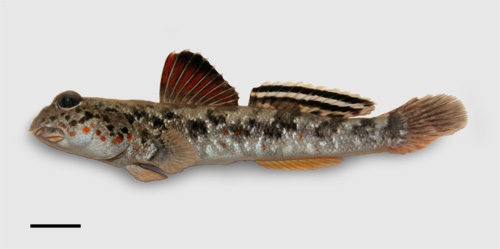
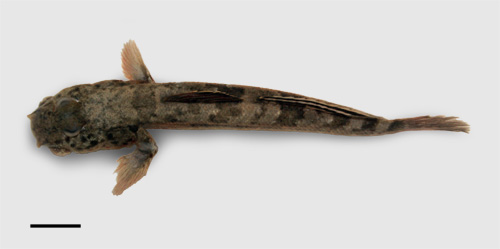
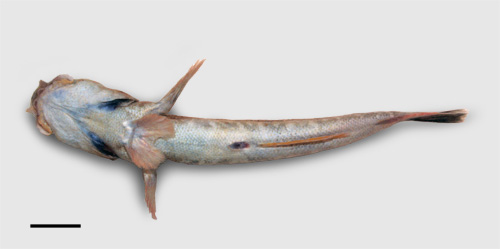
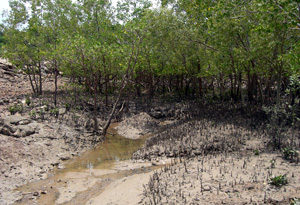
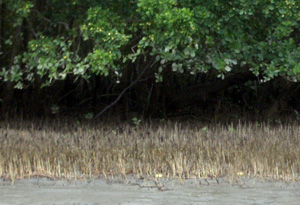
![]()